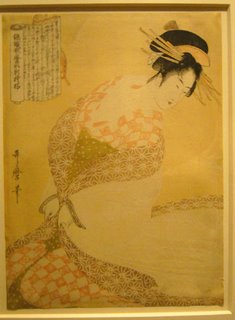
First week: I must have seen this guy back when I toured the Louve all those years ago - but when time is limited -- and Rubens. Poussin, and Delacroix beckon -- I didn't give him a moment's notice. Now though -- with a show all his own -- he's an oasis of splendor in the most threadbare of exhibition schedules the A.I.C. has ever had.
There's a self-portrait right at the beginning of the show that I might pick as his first and last great painting. He was 28 -- it was 1791 -- he was David's crack assistant breaking into his own career -- European history was being made on a day-to-day basis at the national assembly - and he portrays a young man who is sharp, keen, and hungry (much -- much more exciting than the later self-portrait in the Hermitage which is all over Google).
Of course he went on to make many great paintings -- he was a master of space, form, and color -- but he was not a prophet. He mirrored the taste of the rising bourgeoise -- seeking the shallow comfort of gorgeous but petty sensuality that at least never sunk to the sentimentality of Bouguereau and the later academy -- and that deserves to be called decorative -- but what decorations ! I can't imagine living a room surrounded by his life-size figures -- it would be so electric, I would never be relaxed.
The piece shown above was at the show -- and, though thorougly delightful (far more so in person) -- shows the pettiness of his concerns. The lady depicted as Danae was a customer who had rejected his portrait of her -- so he painted her as a goldigger -- her husband as the turkey -- and somewhere in all the detail, a portrait of her lover. The lady was scandalized by society and the painter had his revenge -- but what a cheap use of his great talents.

This is a detail of a very large (and early) painting (which follows) -- showing among all those leaves, I hope, his powerful sense of space -- as well as a hommage to the great master of large-scale dramatic painting: Tintoretto.

There were many more great paintings which I couldn't find on the internet -- but they really have to be seen full-size to get the effect.
Given his abilities - and his frivolous nature -- my greated regret is that he didn't make explicit pornography. I think he could have rivaled the Japanese.
................Second Visit.............

Here's the self-portrait mentioned above -- something about how the facial features line up with how the space is proportioned -- something about the red lips -- and there you have it -- the integrity, the courage, the passion, the drama of a young man.

The first paintings I noticed this time around were the classical historical tableaux -- spinning off from David's "Death of Socrates" or "Oath of the Horatii" -- but almost immediately, it's apparent that the timeless, heroic, serious Classical detachment is gone -- and instead, we're getting some kind of elaborate cartoon -- with grimacing faces that forget they're actors on a Classical stage. (detail of "Joseph and his Brothers" shown above -- and doesn't look like a scene from the Andrew Lloyd Webber musical ?)
Girodet may be the greatest French painter between David and Gericault/Delacroix -- but in comparison with them -- well --- let's just say he feels like a lightweight.

The next painting I noticed this time was the Ossian fantasy he painted for Napoleon (detail shown above) - and with the pretense of classicism gone -- the silliness is actually more enjoyable -- demonic British ghosts battling heroic French ghosts -- surrounded by beautiful ghostly young women, glowing with a supernatural light. It's like the best cover art that trashy pulp fiction has ever had. Napoleon, apparently, didn't like it -- but I think he lacked a sense of humor.

The last paintings that I saw on this visit were the portraits that he did of an older physician, Dr. Trioson, who cared for Girodet when he was a young orphan, and formally adopted him as an adult. I don't know the story behind their relationship -- but the physician is presented as a very kind, caring, rational, and level-headed man -- perhaps a foil to the artist's own whimsical, poetic nature. Actually -- on this visit -- this portrait was the painting that moved me the most. Girodet knows nothing about half-measures --and the character of that father figure jumps out of the frame.
The following is a link to an essay based on the 1911 entry in the Encyclopedia Brittanica:
click hereYou'll notice that the painter is taken to task for trying to express Romantic sentiments within a Classical style -- but I don't know that I want to follow this progression-of-styles approach that is the foundation of academic art history. As I read the character of Girodet the orphan -- I think cherished a fantasy life that semed much more attractive than the cruel world -- and that's where he took his painting. If he were directing films today -- I'd see him as a Steven Spielberg -- and if making movies were an option back in 1800, I think he would have preferred that to painting.
 Ode to Balsam Flowers (detail)
Ode to Balsam Flowers (detail) 















































